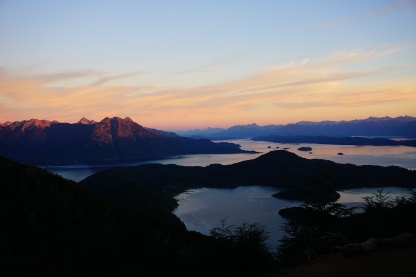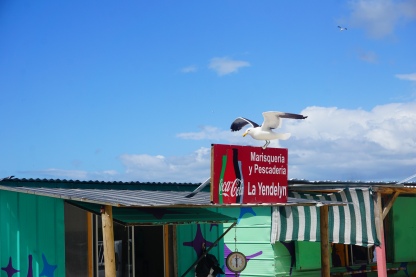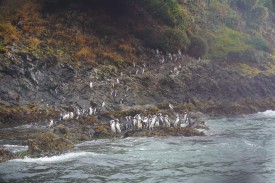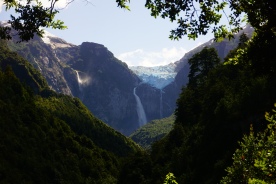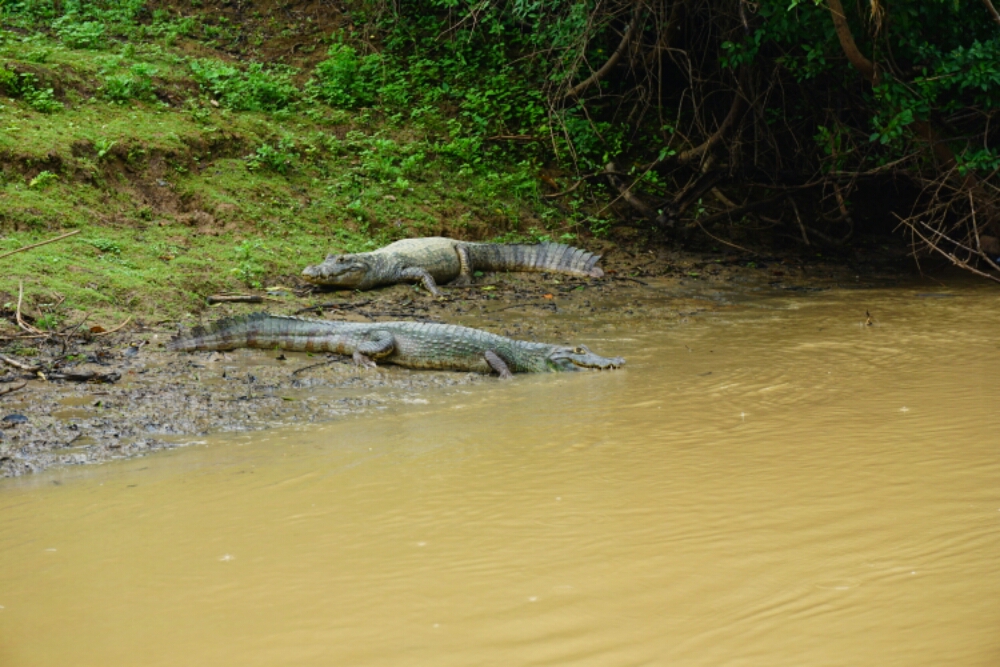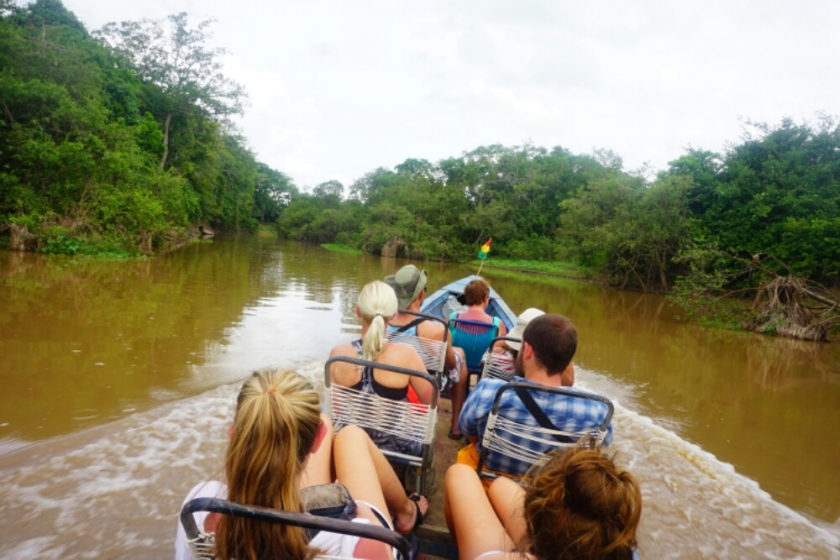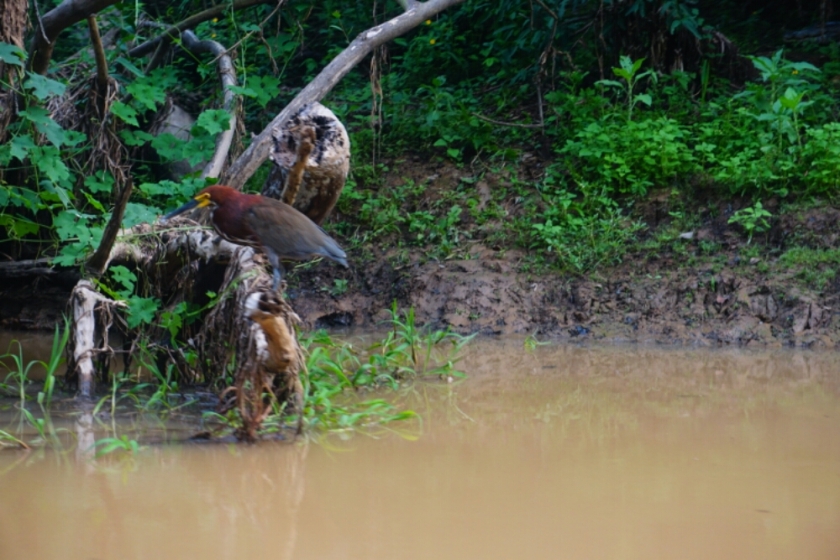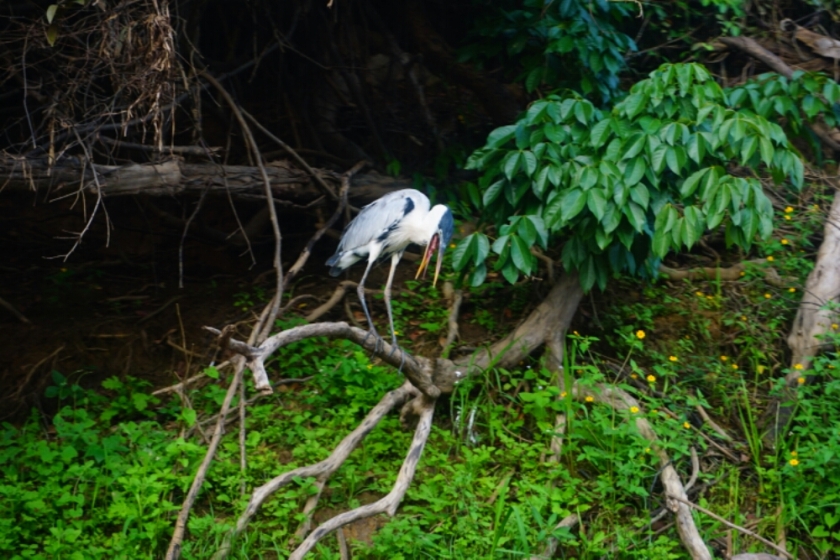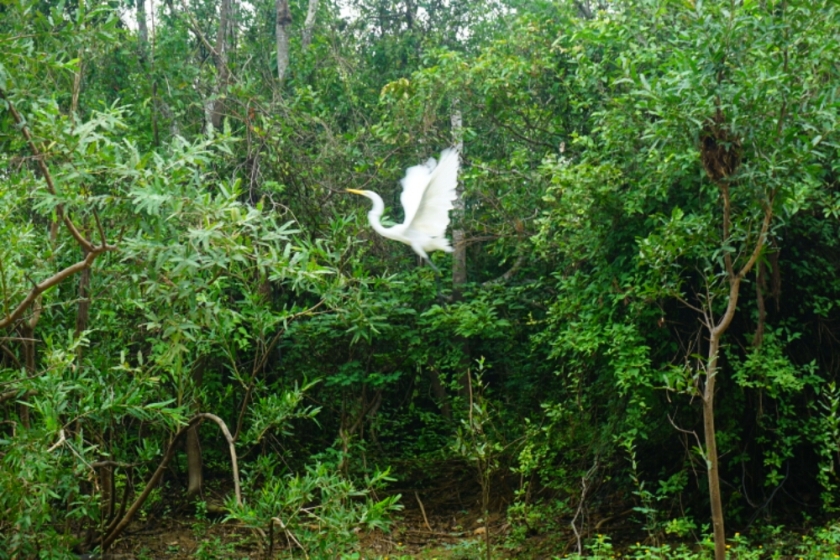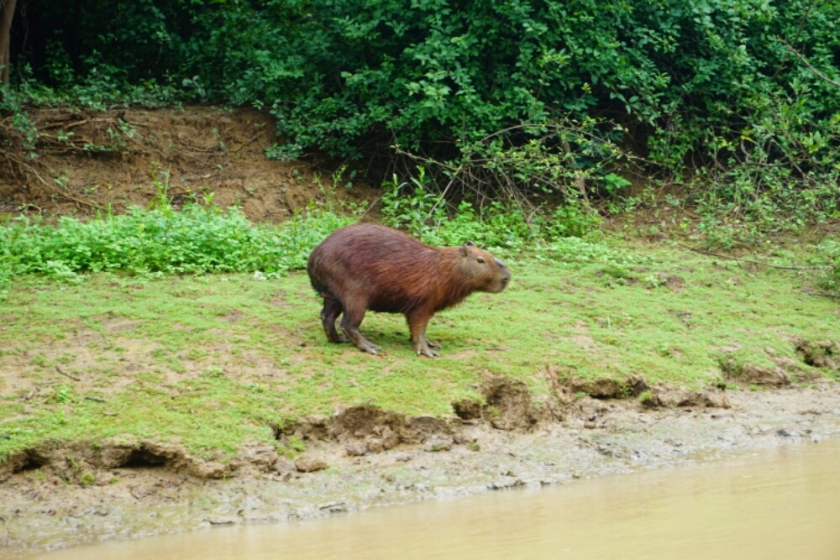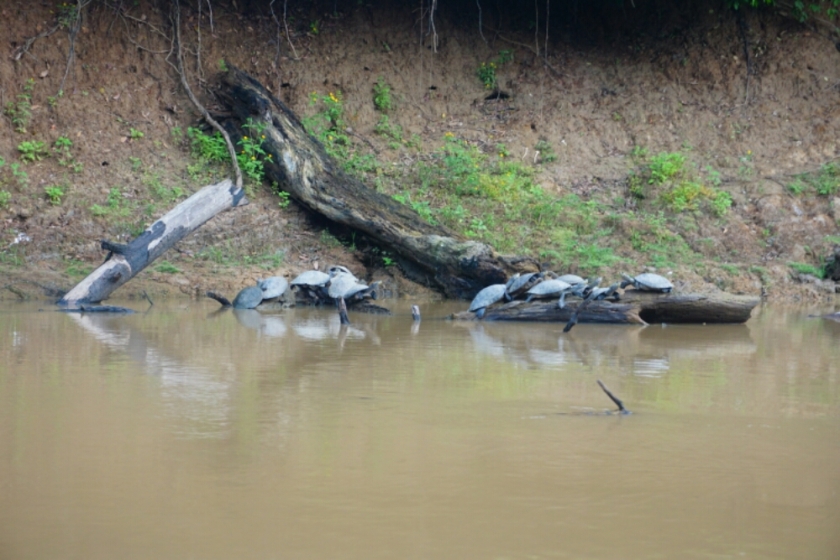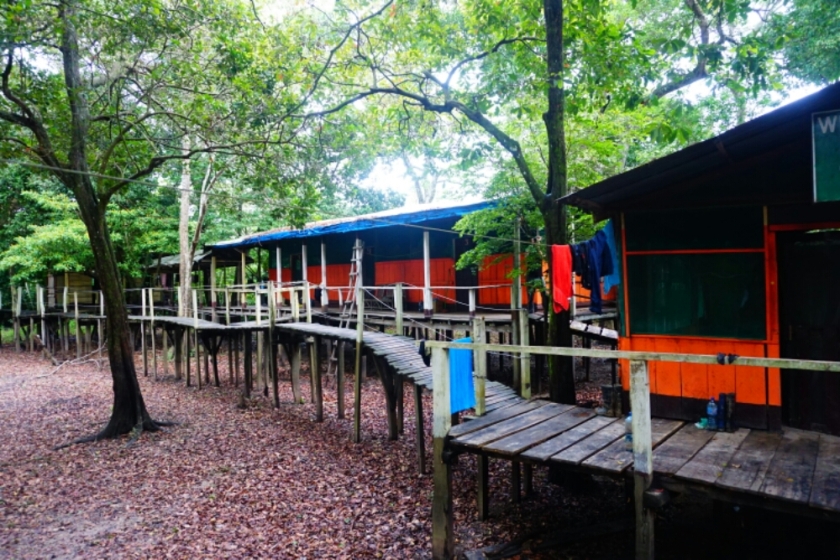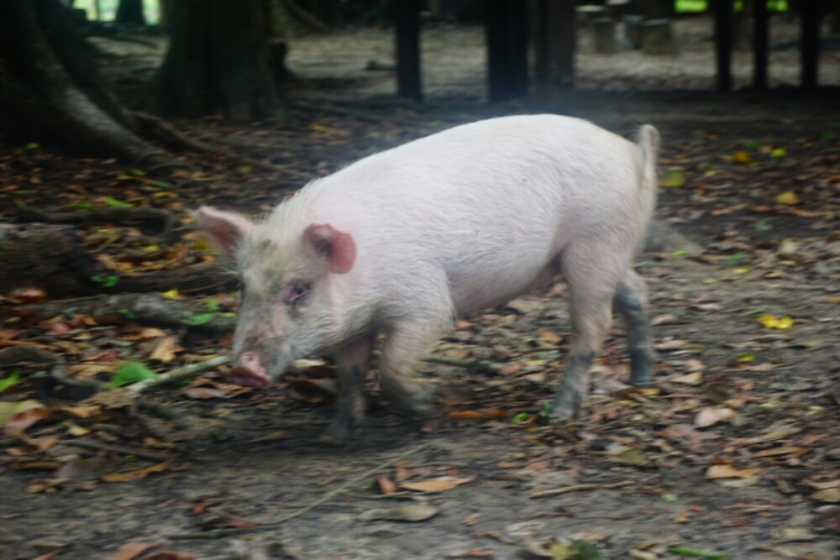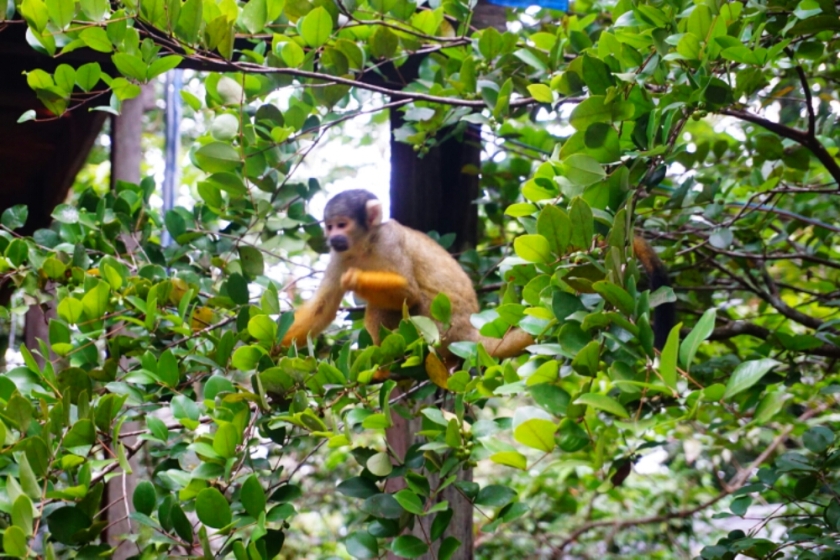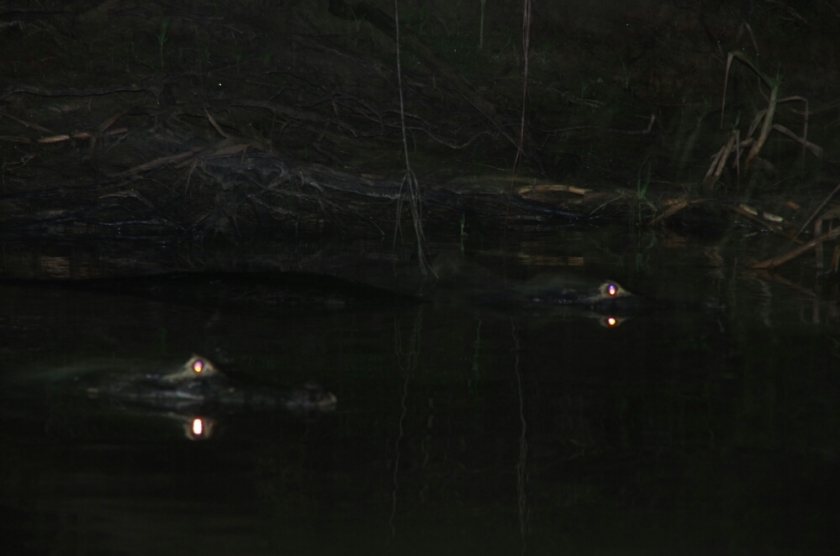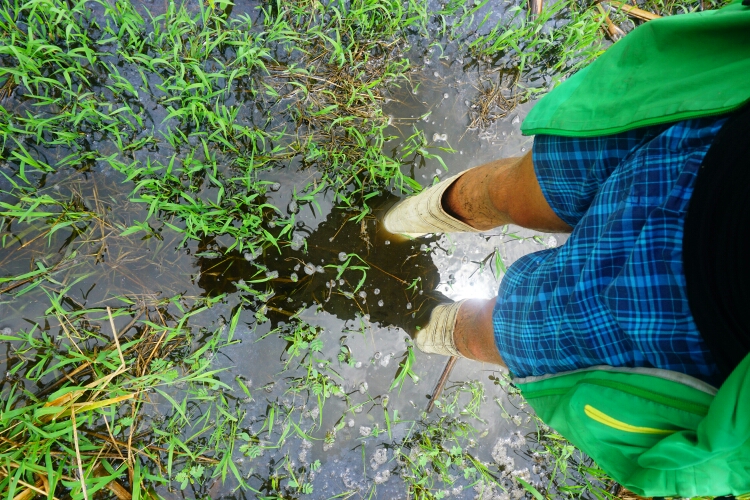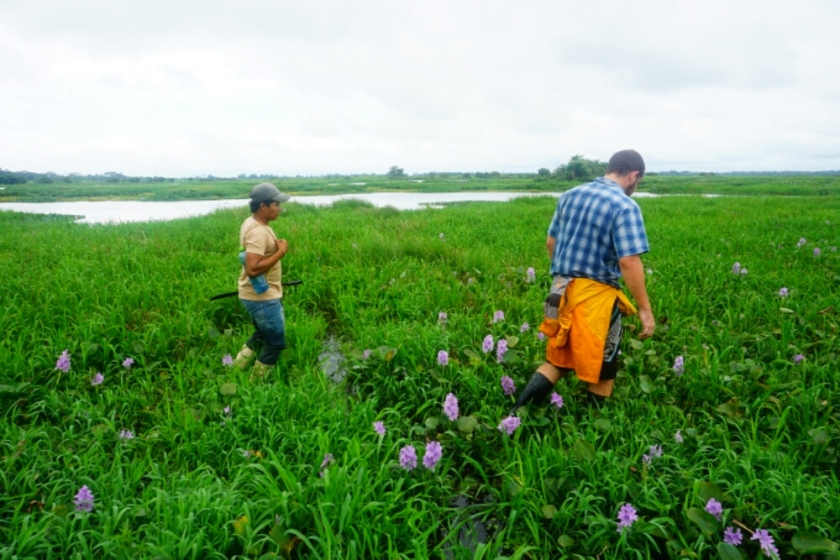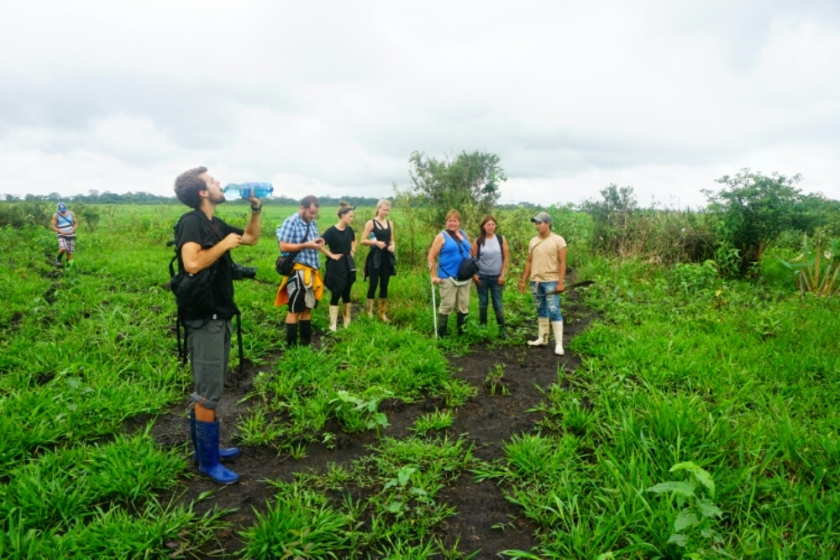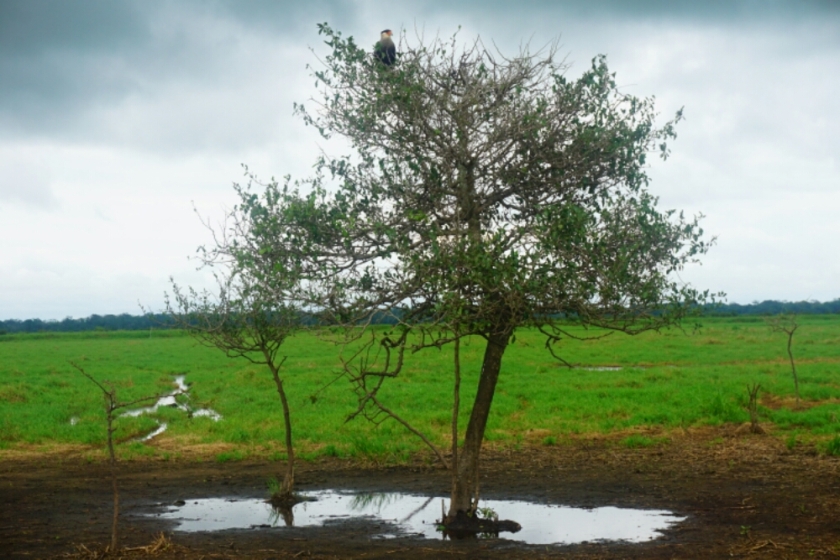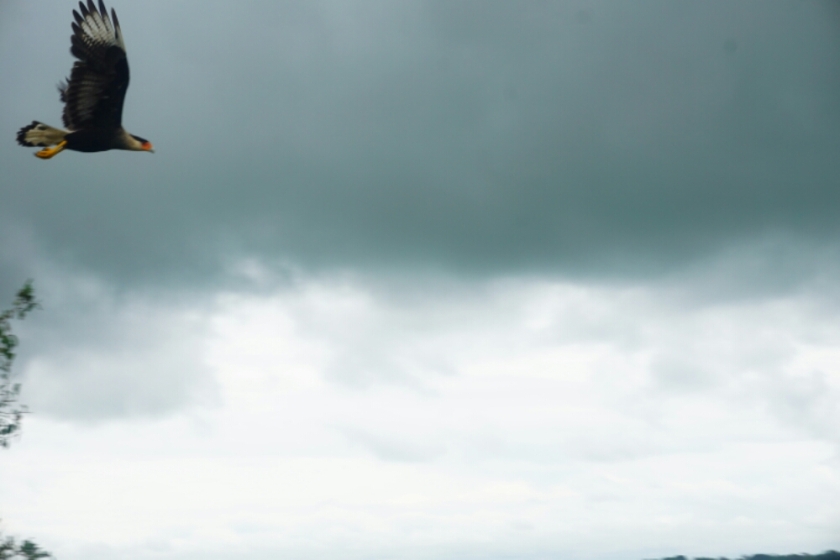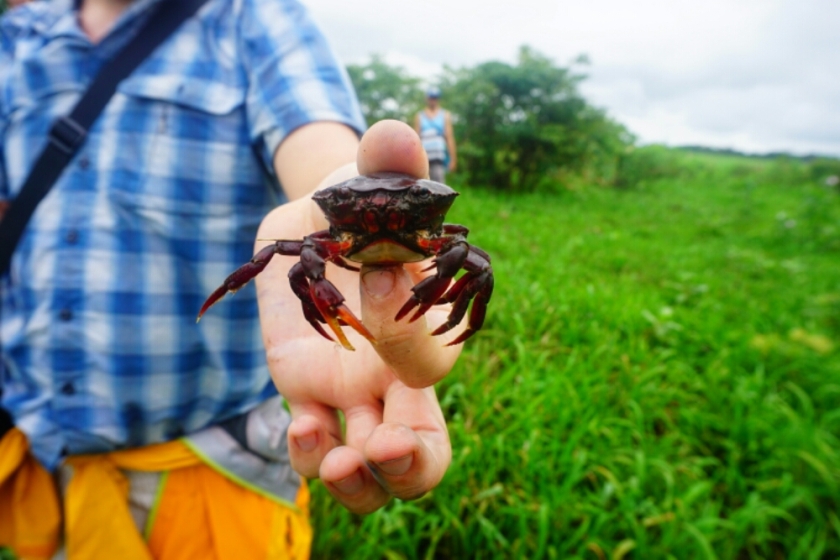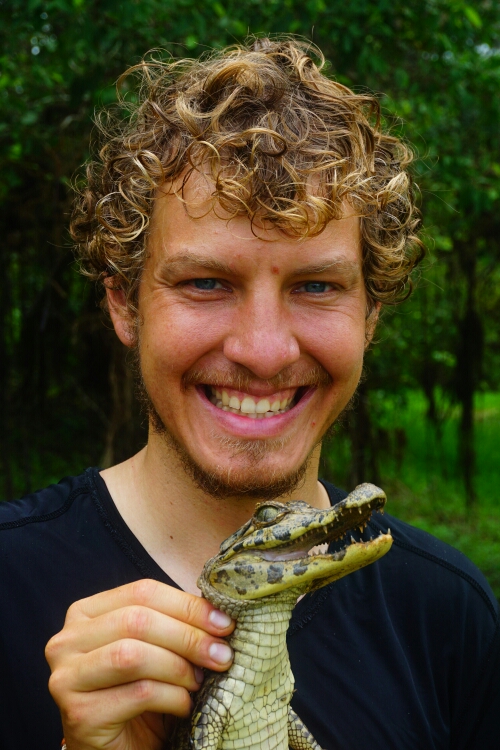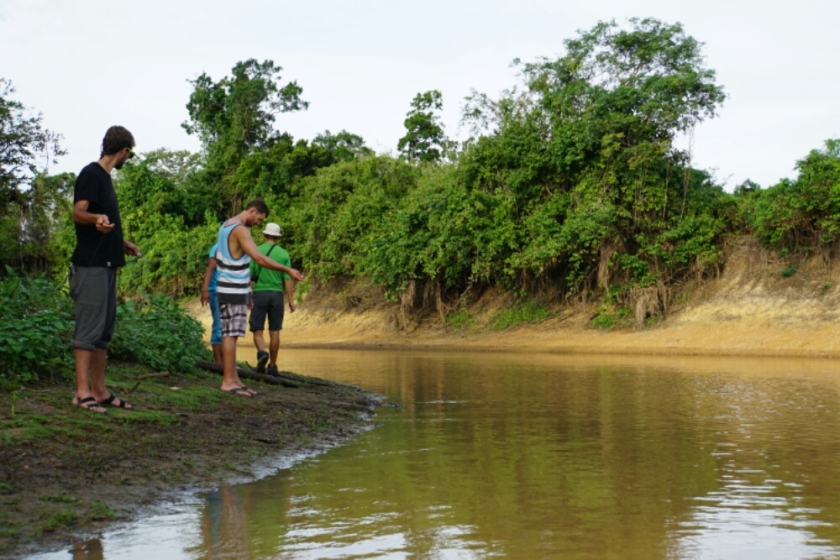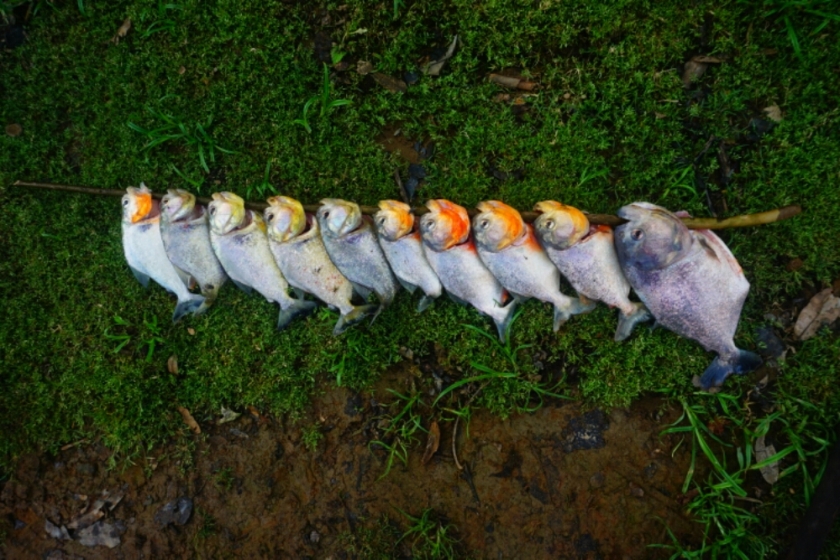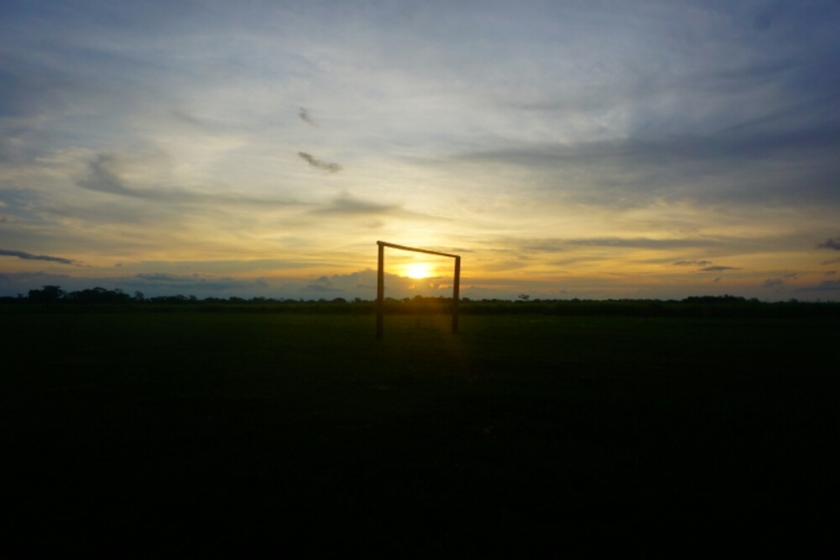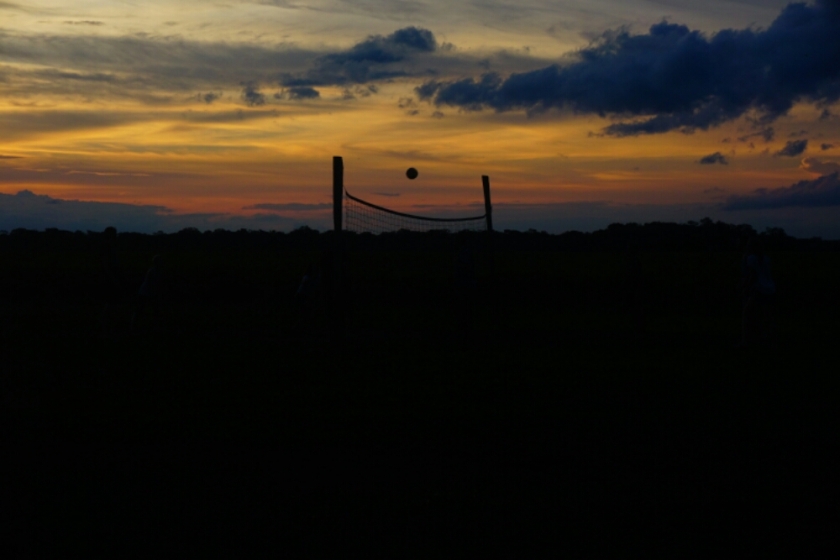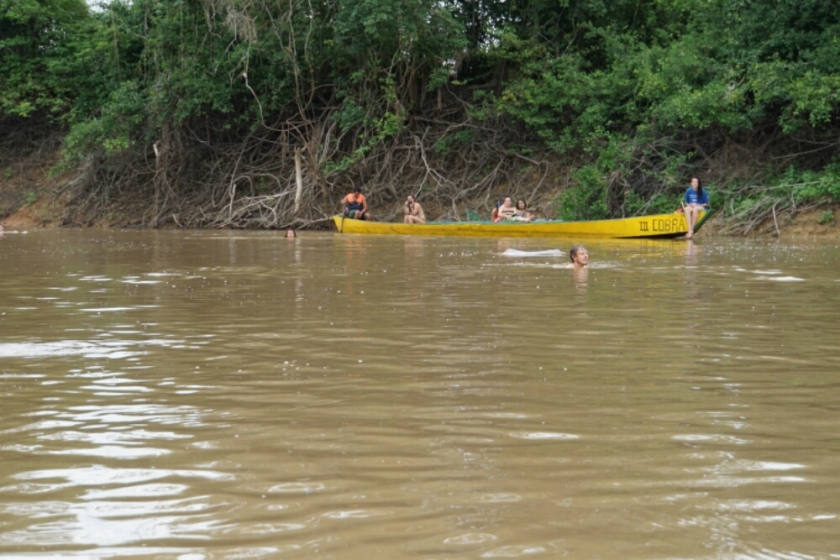Kategorie: Allgemein
The South of Chile and Argentina
The Carretera Austral and Patagonia are two resplendent names on the map of South America, but also the the regions around Temuco, Villarica and Puerto Varas on the Chilean side and San Martin de los Andes and Bariloche on the side of Argentina have a lot to offer. The southwest of the south-american continent is full of blue rivers, lakes, snow-covered mountains or volcanoes and besides cycling there are a lot of trekking options to discover the beautiful nature.
It will be to much to write about everything what I experienced between Santiago and Rio Gallegos, so I decided to pick some of the highlights.
Parque Nacional Conguillío
The name Conguillio originate from the language of the Mapuche people and means water with pine kernel. In the center of this lovely national park is on of the highest volcanoes of this region, called Llaima. In winter it is used for skiing and in summer you can follow the hiking trails passing the high and impressive araucaria trees, nice lakes and cooled lava.
When I entered the park, the volcano was hidden behind clouds, but anyway it was a nice ride and at the end I could see it from the distance while cycling further south.
Villarica and Pucon
When one volcano was not seen anymore, the next one was waiting around the corner. Villarica and Pucon were two nice little cities at the lake Villarica. Between the both I camped directly next to the lake and refreshed myself in the water after a sunny cycling day.
From Pucon I went to some waterfalls and the Ojos del Carburga, a spring pool of a subterranean river, where the water was extremely clear.
Ruta de los 7 lagos, between San Martin de Los Andes and Bariloche
After I left Pucon, I crossed the border to Argentina, where I passed another imposing volcano. A nice welcome present was the free campground just behind the border. Further south I entered the famous ruta de los siete lagos, which has its name from the seven lakes which are between San Martin de los Andes and Bariloche. In this region people from Chile and Argentina spend their holidays.
Bariloche itself wasn’t that nice for me. An ugly town, whose waterfront at the lake Nahuel Nuapi doesn’t invite myself to spent some time. Much more attractive were the numerous mountains in this area, where I decided to discover Cerro Lopez and spend a night at the Refugio. The view was incredible and by looking out of my tent I had an overview over a landscape full of lakes.
Puerto Varas and Isla Chiloe
From Bariloche I headed to Chile again, crossing three lakes with ferries and riding my bike in between the ports. Although it was a little bit expensive it was worth it. On the boat I got to know Ruben, a Argentinian cyclist and in the evening I ended up camping with two more at the lake Llanquihue.
While waiting for a package from Germany I spent one week in Puerto Varas with Constanza, a Chilian girl. She also had some free time and so we discovered the surroundings and also spent two days on the island of Chiloe, where we went to see some penguins.
In this part of Chile and also in the region around Villarica I felt the strong German influence. The Chilian people also use the word Kuchen, which was sold in many places. In Villarica and in Pucon it was possible to buy german bread (panaderia Rostock) and along the streets I could see some german names as labels of different coffee places, restaurants or companies.
Carretera Austral
When I met some other cyclists travelling it was always something special, but the Carretera Austral was so full of them, that we even passed each other without having a conversation. After I left Puerto Varas, I entered the famous cycling route in Puerto Montt and followed it until their end in Villa O’Higgins.It took me about three weeks and most of the time I was cycling with Brian and Andrea, two americans and Jakob, a german. But every day I saw about 10 other cyclists and the ones cycling the same direction were met over and over again.
It was a great time with a lot of wild camping, campfires, dirt roads and a predominant green landscape. One highlight was the hiking of Cerro Castillo, a impressing mountain range, which looks like a castle.
When we arrived in Villa O’Higgins, we were informed that one boat had a hole and needed some time to be rebuilt. Furthermore, due to bad weather conditions, no boat was allowed to cross the lake to Argentina for a few days, so that we met a lot of cyclists (maybe around 40 ) at the campsites in this tiny village, all waiting for the next chance to go on with their travels.
After four nights it was our turn to enter the boat. Afterwards we heard, that the repaired boat of Robinson Crusoe sank, because it hit a iceberg. The passengers needed to be rescued by a helicopter.
Patagonia
My time in Patagonia was dominated by some hikes, beautiful mountains and glaciers. I spent more days hiking than cycling and enjoyed to have some more variety.
Before we reached El Chalten, starting point to hike around the Fitzroy mountain, we had two cycling days with a 6 kilometer section, which is rather suited for walking. But for us it was a welcome relief and another little adventure. Over trunks and stones,through mud and narrow paths it was a very nice part. And after we finished this section we arrived at Lago Del Desierto, where we camped next to the lake and enjoyed the view over the water and the Fitzroy in the background.
The hike over the paso del viento around the mountain Huemul was definitely one of my hiking favorites. With 11 other cyclists and one german backpacker we had four beautiful days in the mountains, walking over glacier ice, astonished by the huge ice field and observing swimming icebergs.
Cycling out of El Chalten I got to know the face of the Pampas with nearly no trees but thousands of yellow shrubs.But not just the colour changed,but also the intensity of the wind. With a solid tailwind I was pushed east, while some days later I was confronted with a head wind, which I had totally underestimated.
Every 3-6 years there is a special natural event happening at the glacier perrito moreno. Due to the climate change most glaciars are shrinking, but this was near El Calafate is growing. The ice wall of a height of around 60 meters is moving forward until it reaches a peace of land on the other side. That leads to a congestion of the meltwater on one side. When the pressure gets to strong, the water pave itself a way under the ice, a hole which gets bigger and bigger until a ice bridge is produced. Due to the weight of the ice bridge and the flowing water underneath, it leads to the point where this bridge breaks and falls into the water. On that day, when this spectacular took place again, I visited the glacier, but unfortunately 40 minutes too late. Anyway, it still was impressing to see this long huge wall of ice and from time to time other big parts fell into the water with a loud crashing noise.
Along my way down south I heart of the beauty of Torres del Paine over and over again and I was aware that it was full of tourists. But most of the time there is a reason for the tourists and Torres del Paine is definitely worth to go although the treks are really full. From some locals I got to know that the airport will be opened to international flights in the next year and the park rangers talked about an increase of 30% compared to last year. I hitchhiked from Puerto Natales and was give a ride by a immigration officer and a family, which first took me to some places off the beaten track and then gave me some snacks and drinks for lunch.Most of the time it’s really worth to hitchhike. For the hike itself I decided to do the shorter „W“-Trek, which included most of the highlights.
With a beautiful ride with the wind in my back I cycled the last two days of my trip from Puerto Natales to Rio Gallegos. It was a lonesome part of the ruta 40 with nearly no cars.I was singing loud with the songs I was listening to, I was observing the wild life around me and I felt happy to have done this amazing tour.
An End Has A Start
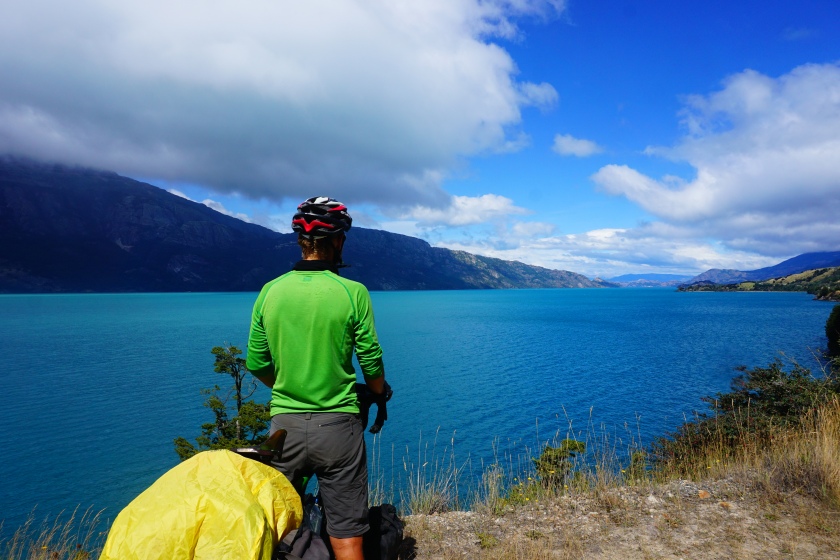
My journey through Latin america had an end, 11 months on my bicycle from Costa Rica to Patagonia in Argentina. How was is? What was the most beautiful place you have seen? What was the most impressive experience? How is it to be back? – That’s what friends and family asked me during my first few days back in Germany. Questions that can’t be answered with a short statement, cause my feelings are too diverse and places and experiences were to different to compare them.
But what I can say, is, that the new start won’t be that hard for me. I soaked up a lot of inspirations, ideas which caused a lot of motivation to put into practice. I found out that all the things I learned need time and space to develop, personal long-term projects which can’t be done during this kind of journey, where I was daily confronted with new topics and new people in different places with different landscapes. It was diverse, refreshing and surprising, but it was not necessary a suitable environment for sustainable development, but rather a breeding ground for insights, for a new mindset, an environment to increase the consciousness. The current question is, what I will do with all these thoughts, how they can enter reality and my daily life. And this is what makes me looking forward to what will come.
New Year, Valparaiso and Santiago
You do never travel alone – besides the people, who follow my travel from the distance, there are more cyclists travelling on the road than you think. The first I met in Costa Rica, two brothers from Argentina and along my path towards all the countries to the the south I’ve got to know over 100 more. Some are cycling north, others south, some are cycling for two weeks, others already for years, some people you meet over and over again, others you will see just for a few minutes or even seconds if you don’t stop to chat. You add them on Facebook, like their travel blogs, follow them on Instagram. With some you decide to pedal together for a day or weeks, unforced, still independent, but happy to share experiences along the way.
So the idea came up to meet in Valparaiso for New Years. 6 cyclists out of around 20 were able to make it in time on their way south. After Christmas and crossing the Paso Aqua Negra, I was late to arrive in time at the agreed place and I wanted to skip the rather unattractive part in between La Serena and Santiago. So I took the bus and this time I first talked to the driver before getting a ticket. And due to the last minute purchase I got a good discount on my ticket and everything went good. I went out in La Calera, where I was invited for lunch and a drive around the area. The guy was the owner of a restaurant, a olive plantation and a transport company, a big fan of Marilyn Monroe and Elvis, collects old cars and motorbikes and seemed to belong to the upper social class of Chile.
The next day I met Vincent again, a canadian cyclist who started from his home town. Together we cycled the last few kilometers to Valparaiso, taking the road over Con Con along the ocean.
Suddenly I spied one cyclist at the boardwalk, then a second and finally 5 in total. By accident our new years bicycle group run up to 11.
The night we spent on Cerro Concepción in Valparaiso, where we had a good view to the firework. Nearby a DJ was playing music, good music, outdoor und a tree, so we danced through the night until the early morning. The next two days we discovered Viña del Mar and Valparaiso, went for a swim in the sea, tasted some local food and walked trough streets full of colourful graffitis.
Big city life with a bike
After one night in the mountains and one night in the Casa de ciclistas in Los Andes, I arrived in the capital of Chile, Santiago. From all big cities during my travel my favourite referring to the friendliness for bicycles. The first evening a critical mass of about 4000 people rode their bikes trough the center and some suburbs, a great start to get to see some parts of Santiago. A bicycle network of 40 kilometers provide a better infrastructure for cyclists than in a lot of German towns. Bike rental stations and guarded bike parking spaces can be found in the city. Mario, a chilenian bicycle activist gave me a map, designed for cyclists with all the important information – great! Besides that the city is close to the ocean and the mountains, has a lot of parks and offers various cultural and culinary sides to discover. But after 5 days I was replete of the hurly-burly and longed for calmness and more cycling trough nature. I went to the bus terminal and went over night to Temuco.
Skin to skin with the Pampas
I’m surrounded by thousands of little lights in the darkness, some steady at the ceiling, others blinking around me and some seems to be underneath. The visual appearance is accompanied by a cloud of constantly humming noises sometimes drowned by croaking noises. I’m sliding slowly through this atmosphere until… somebody puts on a flashlight and I’m back in reality, back on the river, surrounded by sounding insects, the stars of the sky and the blinking lights of humming birds, whose lights are reflecting in the water.
I’m surrounded by thousands of little lights in the darkness, some steady at the ceiling, others blinking around me and some seems to be underneath. The visual appearance is accompanied by a cloud of constantly humming noises sometimes drowned by croaking noises. I’m sliding slowly through this atmosphere until… somebody puts on a flashlight and I’m back in reality, back on the river, surrounded by sounding insects, the stars of the sky and the blinking lights of humming birds, whose lights are reflecting in the water.
3 days and two nights we spend in the Pampas, near Santa Rosa, in, on and close to the river Yacuma. After a three hour bus trip we changed into a long boat which was head a powerful motor at the back.
The riversides were full of animals and so we saw heaps of alligators, turtles and huge birds as well as some capibaras and caymans.
We were staying in one of the lodges along the river, where we had further animals to observe, like Luisa, the pig of the house and all the little monkeys, which were frolicing around.
In the first night we entered our long wooden boat again to observe the alligators by night. Their eyes reflected the lights of our torches, so that we could see all the yellow lights all along the river.
Our guide Gary fetched a little baby alligator so that we were able to hold it and feel the texture of the flaky skin.
The next morning we discovered the area next to the river, traversed head-high reed, small rivers with the water up to our knees or swampy pont-water. The idea was to find an anaconda, but although we were trying hard with the help of our experienced guide we couldn’t find one. But still it was an adventure and we saw an eagle and further animals.
Notice the king of the air in the treetop.
Gary pulled another alligator out of the thicket, this time a little bit bigger then the one from the night before.
The afternoon we were in the river again and this time we stopped to fish Piranhas. It was amazing how fast we were able to fish them, not 5 minutes passed as I got the first piranha in my line. But it remained the only one, although it was always able to feel how the fish nibbled on the meat. At the end we had enough for dinner. At the end we found out that they just had a little meat inside, but it was tasting good.
Before going back to our lodge we stopped to see a beautiful sunset over the Pampas.
The last day we were riding on the river again to find a spot where we could swim with the river dolphins and after a few minutes of searching we really found them. They were not that trusting as I thought they would be, but here and there they showed themselves, emerged, dived into the water again and passed us without us noticing it. We were told that they would also protect us from all the alligators and caymans which were also hanging out around us. And also the Piranhas kept away from us.
It was definitely a very good experience to see all the animals and to feel the liveliness of the nature. While this entry gets online, we will be on a boat with our bikes to go to Guanay, traversing the jungle of the national park Madidi.
Panamá City and the National Park Soberania
The loud noises of the city accompanied my in the city. Although Panama City is just as big as cologne it seems much bigger. Several skyscrapers dominate the picture of downtown. But this is just one face of the capital. The areas just behind the big bridge are very poor. Some of the buildings in these areas are still quite high but not with much glamour. People were trying to sell sweets or drinks along the inner city highways, carrying their stuff in buggies. And then there is Casco Veijo, which carries the history of the colonial time in their streets, ruins and churches, museums and narrow streets. About 4 years ago, it was the part of the city, where artists and creative people lived. But with the renovation of this district, rich people came to settle there. The rents rose and the former inhabitants moved to other parts of the city. We know this by some other German cities like Berlin or Hamburg. In Casco Veijo, the charme of this areas remained and the difference of the former and the new center of the old time is pretty interesting within the time of change.
After too many days in the city, I went on to go to the Caribbean Sea. From this day on I’m cycling alone.
Early in the morning I went a second time to the Mirraflores Docks, cause there weren’t any big ships during the first time we went there. (You have to know that the switch the direction for the big container ships in the middle of the day and that it takes a while until they passed the whole path between the two seas). The second time I was pretty much 2 hours to early, and so the security whistled back myself. I went on to the next docks in San Pedro, where there was no entrance for visitors but still a spot where I could get s glimpse.
2 kilometers further I stopped in the bridge to observe the big container ship goin through the canal.
At around 9 I arrived at the border of the national park Soberania, where I left my luggage to do a hole in the camino de plantación, a path trough the jungle, which was build during the construction of the canal for the transportation of goods. It ended a the the camino de crises, which was one of the major path during that time. I enjoyed my walk in between the big trees and the diversified vegetation. Along the path I could see various animals, like monkeys, lizards, frogs and some more which I couldn’t define.
The next day was the first day full of rain. Before there were some days with some more or less heavy showers, but in this day it was raining all day through. On the way to Portobelo I met Jeff and Roselind from Canada ( Shift happens) . After a short but nice conversation with sharing some tips, I arrived in
Portobelo in the middle of the day. Perfect timing, because just after I had taken a shower, I went on a sailing boat which will bring me across the Caribbean Sea over the San Blas Islands to Cartagena. When everything works fine, the Calypsa (calypsatours.com) will leave Monday afternoon.
From Garden Eden to the big town Panama City
Some days ago I uploaded some pictures of the Garten Eden without telling you about this place, whee we met Patrick, who lived in Leipzig and owned an organic shop before he left Germany. Finally he settled down in Uvita, a little village at the Pacific. After managing a hostel, he began to build the Garden Eden. Two German girls and one american guy stayed at this place as well and because of having a nice atmosphere at this place and inspiring conversations, we stayed there for three nights. All the guests helped him during the morning to build up a roof in the front of its house, clean up the house, water the garden and do some other tasks. Therefore we could it ate and sleep at his place. During our stay we only ate raw food, so vegan and nothing cooked. But we always conjure tasty stuff like Guacamole, hummus, smoothies and different kinds of salads. The house itself was an open house, so most of the „rooms“ had no walls around. I slept in a hammock for the first time and felt quite comfortable. On our last afternoon the visit of the nearby waterfall was beautiful as well and refreshing compared to the temperature of the warm ocean.

The trip had to go on and we went on to pedal down south. The next two nights we slept in the backyard of locals, whose hospitality is amazing. They offered us juice as well as fruits and water. Using their bathroom seemed to be the most common thing on earth. Well, this is how it should be, right?
In between we had to cross the first border and so we were curious if all things will work. After we had to pay the exit tax, we had to get the exit stamp on the side of Costa Rica. With this we went to the border, where they wanted us to show them a proof, that we will leave the country. Neither we had a flight ticket, nor any other proof. So they wanted us to show them our credit card or 500 $. We were prepared and so we could pass to Panama without any bigger problems.

One of the highlights in Panama, were the stay in Gualaca and the visit of the surrounding area. We stayed at a german woman, who one lived in Remscheid. She took us on a tour to her favourite places. A little canyon, a waterfall and two suspension bridges as well as a resort with rented houses and a tree house, operated by an old American guy with his young well-trained partner from Panama.
The next day we slept in a police station right next to the Panamericana, and as a present we got a pineapple right according to the motto of the police „protect & serve“.
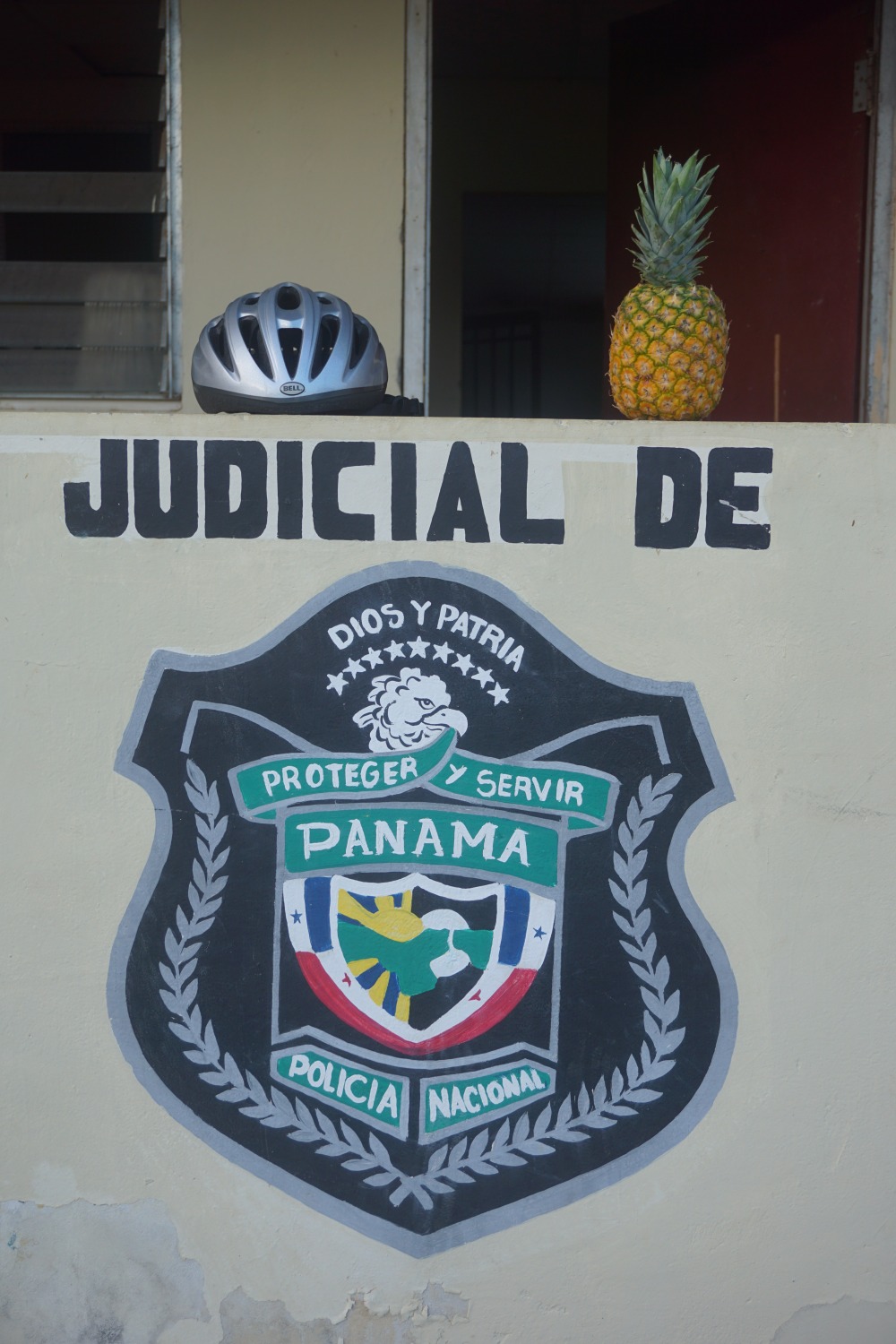
One day before reaching Panama City we asked again at a police station near Coronado and again the served us. A policeman drove through the town to ask for an accommodation for us, returned and escorted us to the place. What a service.
Today we reached Panama City and it was really amazing to cross el Puente de las Américas, very impressive and one of the highlights so far.

The next days we will spent in the city before we will go up the channel to Portobello, where we want to catch a boat to Cartagena.
Well, how is it goin with my tyres, I got asked. One day after I wrote my entry about all the breakdowns, it became better,BUT it was not the end of this episode. A thunderstorm was going to show up and so it was the perfect time to have another flat tyre. Unfortunately Paula also didn’t realized that my misfortune pounced on me again. This time nails of a stapler wanted to have a look into my outer tyre to greet the tube. I found three of them stucked in the outer tyre. And although the procedure of getting out the tube, close the leak and reset my tyre became a ritual during these days, the rain came faster then I could get back on my bike. But I was lucky, cause I found a shelter before an intense rain in combination with thunderbolt began to rage. So, I needed a new repair kit and from that day on the fortne find its way back to me. 🙂
I updated the map with the marks of our night stops, which you can find here.
More pictures can be found on my Flickr Account.
Stadt, Land, Fluss, Meer
..or also San José, Puriscal, Rio Parita, Pacific and so much more inbetween. A week passed and I don’t know where to begin and where to end my Post.
For the flight everything went totally fine, no problems to enter Costa Rica and my lovely bike didn’t get hurt. I rebuilt my companion and was navigated 30 kilometres through San José to my first destination in the eastern part of the town. The Ticos call their town Chepe, which is the nickname of José and a term of endearment. I really enjoyed the time with the people I met and I got rid of my jetlag. The town itself I didn’t like that much, a lot of traffic coming with dirty air, rather less beautiful houses and not many green parts. And although the appearance of the town couldn’t give me anything, it wasn’t easy to leave this place. A first Goodbye of many that will follow.
I got warned of the altitude of my trip to Mastatal and so I took the bus, yeah I really took the bus in my actually first day of cycling. Well, this decision was maybe the best I took in a week. Although I only had to cycle around 40 kilometres I was out on my feet reaching Mastatal. The heat and the mountains, belligerent dogs, gravel roads and two flat tires withdrew a lot of power and concentration. After one night at the eco-farm, the tour went on through the mountains, down some roads full of stones where it was hard to keep the balance. After reaching the Rio Parrito we were pedaling down towards the ocean, but it would take one more day before we could see the waves crushing on the beach. Another flat tyre was so cheeky to show up, yeah number 3 in 3 days. In the afternoon it came to the point to find a place for our tent for the first time. Not that easy, as I thought before. But at the end of a street in a small village we got offered a place in the back of a house, or let me say, rather tin shack. And although the owners were quite poor, they provided us their place, gave us some cold juice and offered us their bathroom to take a shower.
The next day the Pacific was getting closer, but before that I got really stressed by my back wheel. Day 4 and some more technical presents kept ready to approach. Another 3! Times a had to stuff holes in my inner tube, always somewhere else. After the analysis in the strong heat of the sun didn’t came to conclusion about the reason, my spare outer tyre came to its first employment. 6 flat tyres in 4 days! Unbelievable. Some cold water and a bath in the ocean brought back the good mood. We met two guys from Argentina who will cycle home all the way down. Seems as if it’s high season for long way cyclists, cause I know from another group of four Germans and one Russian guy, who are around somewhere. As we had to move on, we told them that we will definitely meet again on our way south and maybe could watch the upcoming semi final of the champions league together, cause one of them was a big fan Barcelona.
We reached the garden Eden in the evening, where it is raining like standing underneath a waterfall. Before I will write more about this inspiring place, I will leave you with some photos, I uploaded on Flickr:
https://flic.kr/s/aHskanZKST
Way up north
Days are passing by, in less then 8 hours I will be on my way to Hamburg and all my stuff is still on the floor as it can be seen on the photo. The last few days were full of preparations and I really want to be on the road now to throw out all of the thoughts concerning the equipment.
But the days on my desk are over for a while and instead of a keyboard my hands will get along with a handlebar. The first part of my test drive to the north will lead me to Mannheim, will go on to Mainz and along the Rhine to my hood I grew up in. And if everything goes well the 1k will be pedaled until Easter Sunday.
In the meantime, I enjoyed my first weekend trip on my two-wheeled turtle around Stuttgart. And it was not just my experience with a loaded bike, but rather the circumstance of a fellow traveler, whose attendance will now accompany me in Latin America. Paired with my first warmshower experience, the passed weekend was exciting and valuable.
Before I will pack all the weight on my green and stable but heavy bike, a short homage to my road bike, whose lightness and dynamic is just amazing to generate the feeling of just sliding up the mountains. The last drive through the vineyards for the next months was framed by a beautiful sunset and a good companion:
–
Die Zeit geht vorbei und in weniger als 8 Stunden werde ich schon auf meiner ersten Etappe nach Hamburg sein während mein ganzes Equipment noch auf dem Boden verteilt herumliegt. Die letzten Tage habe ich nochmal einiges vorbereitet und bin nun froh, morgen endlich auf dem Weg zu sein und alle Gedanken zu meinem Equipment aus dem Kopf streichen zu können.
Die Tage an denen man täglich am Schreibtisch sitzt, sind erstmal vorbei und meine Hände müssen anstatt der Tastatur nun mit dem Radlenker Vorlieb nehmen. Der erste Abschnitt meiner Testfahrt in den Norden wird mich nach Mannheim führen bevor es dann über Mainz entlang des Rheins in meine Heimatstadt geht. Und wenn alles gut läuft werde ich die ersten 1000 Kilometer am Ostersonntag hinter mich gebracht haben.
Zwischenzeitlich bin ich mit meiner zweirädrigen Schildkröte die erste Wochenendtour um Stuttgart gefahren. Neben der Raderfahrung mit Gepäck war das Kennen lernen meiner Mitfahrerin aufregend. Zusammen mit meiner ersten Warmshower-Erfahrung ein sehr tolles Wochenende mit mit vielen wertvollen Eindrücken.
Bevor nun die ganze Ausrüstung an meinem grünen und stabilen, aber auch schweren Bike seinen Platz findet, noch eine kurze Hommage an mein Rennrad, dessen Leichtigkeit und Dynamik ich sicherlich ab und an vermissen werde, wenn ich bei hohen Temperaturen die Andenpässe hoch kriechen werde. Die vorerst letzte Rennrad-Tour durch die Weinberge wurde durch einen wundervollen Sonnenuntergang und einen guten Freund begleitet:
A new bike is born
It took me longer then I expected due to several reasons, but finally a new bike is born and it feels really good. It is the first one I’ve ever built on my own and the work was really worth to have done. I gained a lot of experience and I can highly recommend to build it on your own, when you are going to a longer travel on a bike. Here I will tell you three things you should take care of:
– I had problems to tighten the screws of my brake levers due to no space to put my screwdriver into an upright position. So I removed the lever from grip, which means loosen the spring. I really bad idea, because it takes age to get it fixed again. So NEVER do that!
– To connect my hub dynamo with the front light, the task was to get the cable through the bike fork. My first attempts to push it through weren’t that successful. Then I read about the idea to take a fine thread and vacuum cleaner. Sounds a bit weird but it was very effective. After vacuum the thread through the fork, I fastened the cable to it and pulled it back through the fork. With a little hook the cable was ready to connect.
– My Rohloff Speedhub was delivered without the oil inside of the gear. Unsuspecting I cycled my first tour without the oil which has to be filled in. Fortunately not a big thing, according to Rohloff there are no defects after one year riding.
After all the experiences while building my bike, it felt great to listen to the first sighing of the wind, to cross the bridge leading to the snowy forest of Sindelfingen and watch the daily traffic slowly creep along the highway. Will there ever be traffic jams caused by to many bicycles?
_
Durch mehrere Gründe hat es länger gedauert als erwartet, aber letztlich wurde ein neues Fahrrad geboren, welches bei seiner ersten Tour direkt einen Sonnenaufgang erleben und sich mit den Schwierigkeiten von Schnee und Eis vertraut machen durfte. Es fühlt sich gut an, endlich im Sattel zu sitzen und sich an ein neues Fahrgefühl zu gewöhnen. Es ist das erste Fahrrad überhaupt, welches ich aus Einzelteilen aufgebaut habe und die Erfahrung war es auf jeden Fall wert. Ich kann auch nur jedem/-r Reiseradler/-in empfehlen, sein Rad selbst zusammenzubasteln. ich habe hier mal drei Punkte herausgepickt, auf die man achten sollte:
– Ich hatte Probleme meine Schalthebel am Lenker zu fixieren, da die Schrauben mit dem Schraubenzieher und auch flexiblen Gerät schwer zu erreichen waren. Und so kam ich auf die Idee den Hebel vom Griff zu entfernen, wodurch ich auch die Rückschlagfeder lösen musste. Eine ganz schlechte Idee, denn die Reparatur hat mich mit Hilfe von Klebeband ca. 2 Stunden gekostet. Tipp: Nicht nachmachen!
– Um meinen Nabendynamo mit dem Licht zu verbinden sollte das Kabel durch die Radgabel verlegt werden. Meine ersten Versuche das Kabel einfach durchzuschieben schlugen fehl. Nach kurzer Recherche war der Tipp einen Staubsauger und einen Faden zur Hilfe zu nehmen. Klingt zunächst etwas seltsam, aber letzten Endes war es sehr effektiv. Faden durch die Gabel saugen, Kabel dranbinden um dann den Faden wieder zurückziehen durch die Kabel. Dann noch mit einem kleinen Haken das Kabel aus dem Loch hebeln und an den Nabendynamo anschließen.
– Rohloff Schaltungen im Laufrad werden in der Regel ohne Öl im Getrieben ausgeliefert. Unwissend bin ich meine erste Tour ohne das noch einzufüllende Öl gefahren. Beruhigt war ich dann durch die Aussage von Rohloff, dass ohne Öl im Getriebe auch nach einem Jahr keine Defekte aufgetreten sind.
Nach den ganzen Erfahrungen während des Zusammenbasteln, fühlte es sich gut an dem ersten Rauschen des Fahrtwindes zu lauschen, die Brücke in den winterlichen Sindelfinger Wald zu überqueren unter der der tägliche Verkehr langsam hindurch kroch. Ob es jemals Staus durch zu viele Räder geben wird?




















